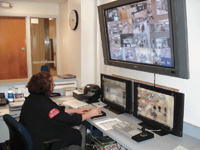A New Role for Video
 The convergence of video surveillance, access control and other security systems with IP networks is opening up new opportunities for retailers who support them. In fact, ABI Research believes the video surveillance market is poised for explosive growth, from about $13.5 billion in 2006 to $46 billion in 2013.
The convergence of video surveillance, access control and other security systems with IP networks is opening up new opportunities for retailers who support them. In fact, ABI Research believes the video surveillance market is poised for explosive growth, from about $13.5 billion in 2006 to $46 billion in 2013. Technology is evolving quickly. Cameras are becoming more powerful and higher resolution, analytics are growing more sophisticated, application-specific and are shifting from computer to camera. Data compaction algorithms are improving, and users are experimenting with wireless applications. These developments are fueling a whole new venue for video data in retail, well beyond physical security.
Analytic Benefits
The ability to use a computer rather than a human to analyze images is revolutionizing the use of video. By configuring analytic software to look for specific changes in pixels, retailers eliminate the tedious, labor-intensive and error-prone task of screening images in search of problems.
Video surveillance hardware is evolving rapidly. It's becoming smaller, cheaper, easier to integrate and use, scalable and more frequently uses Power-over-Ethernet (PoE), eliminating the need to run electric to camera locations.
Systems can be programmed to send alerts, for example, notifying a manager or loss prevention officer to shoplifting, employee theft, loitering or other potential fraud incidents. Alerts also can be used in association with marketing and operations-related video data, including people counting, traffic patterns, promotion evaluation and training.
Retail + ROI
Successful detection and prosecution of theft incidents will continue to lead retailers' priorities for video surveillance. Technical improvements are making it easier and cheaper to more extensively protect goods and people.
Centralizing video management and analyzing data delivers real benefits, but video surveillance systems pay even more dividends when integrated with point-of-sale, access control and electronic article surveillance systems.
Despite the downed economy, grocers, discount and automotive retailers are investing in video surveillance systems. Potential sources of return on investment include deterring both internal and shopper theft, increasing successful prosecutions and protecting against lawsuits, as well as the labor savings from remote management and monitoring.
As video breaks out of the bounds of proprietary CCTV systems, it also breaks out of the security pigeonhole. By affordably addressing security concerns, retailers add a powerful new type of data and an array of technical tools in order to better understand and manage their businesses.
To read this article in its entirety, visit VSR magazine's Web site: www.verticalsystemsreseller.com





